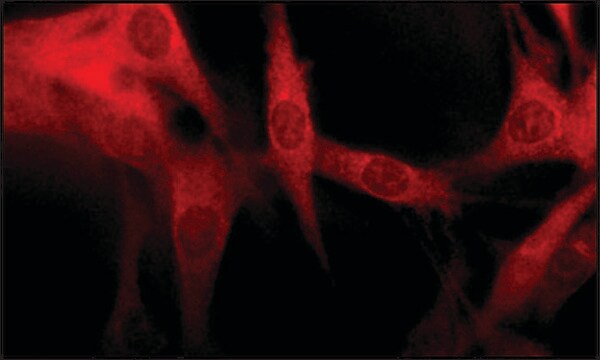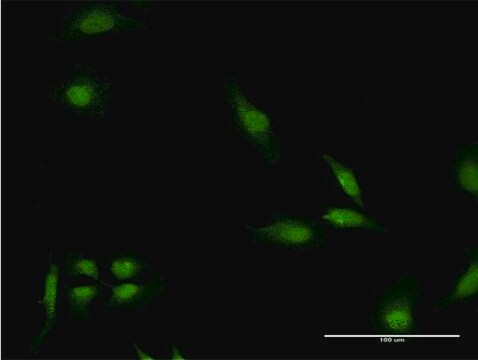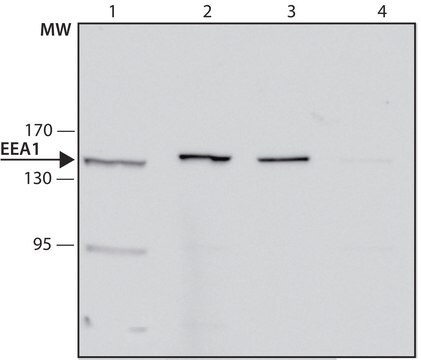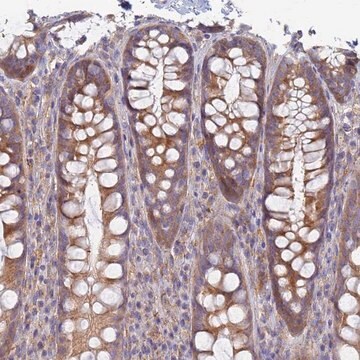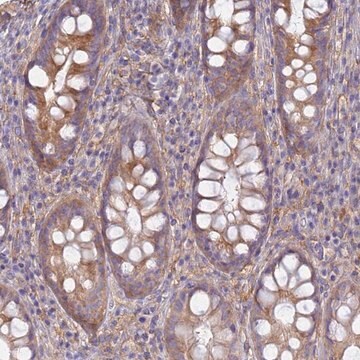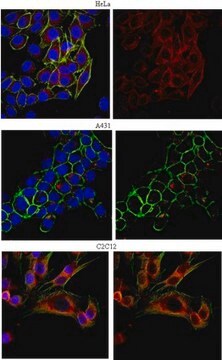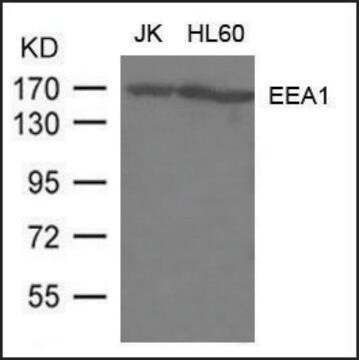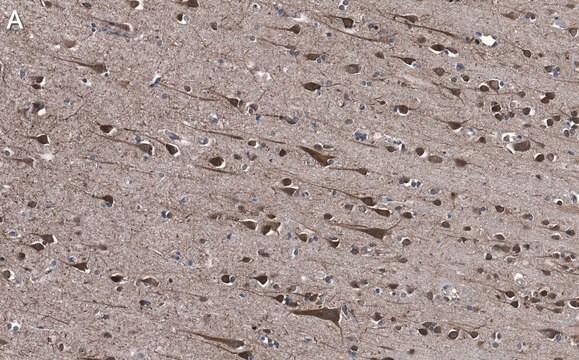추천 제품
생물학적 소스
rabbit
Quality Level
결합
unconjugated
항체 형태
affinity isolated antibody
항체 생산 유형
primary antibodies
클론
polyclonal
양식
buffered aqueous solution
분자량
antigen ~160 kDa
종 반응성
mouse, human, rat
농도
~1 mg/mL
기술
indirect immunofluorescence: 5-10 μg/mL using human HeLa and rat NRK cells
western blot (chemiluminescent): 0.4-0.8 μg/mL using whole extract of mouse NIH-3T3 cells
UniProt 수납 번호
배송 상태
dry ice
저장 온도
−20°C
타겟 번역 후 변형
unmodified
유전자 정보
human ... EEA1(8411)
mouse ... Eea1(216238)
rat ... Eea1(314764)
일반 설명
The gene Early Endosome Antigen 1 (EEA1) encodes for around 1400 amino acid proteins. It is a peripheral membrane protein associated with the cytoplasmic face of early endosomes. It is a 162 kDa autoantigen protein. EEA1 is a dimer, which comprises extensive coiled-coil regions. At its C-terminus, it contains a cysteine-rich zinc-finger-like domain named FYVE domain. This FYVE domain is conserved from yeast to man. FYVE domain is implicated in the specific localization of EEA1 to endosomes.
면역원
synthetic peptide corresponding amino acid residues 24-40 of human EEA1 with C-terminal added cysteine, conjugated to KLH. The corresponding sequence is identical in mouse.
애플리케이션
Anti-Early Endosomal Antigen 1 (N-terminal) antibody produced in rabbit has been used in immunoblotting and immunofluorescence.
생화학적/생리학적 작용
Early Endosomal Antigen 1 (EEA1) localization in endosomes is implicated in subacute systemic lupus erythematosus. Endosomal targeting of EEA1 also requires its binding to the active form of the small GTPase Rab5. The binding of EEA1 to phosphatidylinositol 3 phosphate (PtdInsP) and rabaptin-5 (Rab5)-GTP is essential for the localization and function of EEA1 in endocytic membrane fusion. Anti-EEA1 may be used as an early endosome marker.
물리적 형태
Solution in 0.01 M phosphate buffered saline, pH 7.4, containing 15 mM sodium azide.
면책조항
Unless otherwise stated in our catalog or other company documentation accompanying the product(s), our products are intended for research use only and are not to be used for any other purpose, which includes but is not limited to, unauthorized commercial uses, in vitro diagnostic uses, ex vivo or in vivo therapeutic uses or any type of consumption or application to humans or animals.
적합한 제품을 찾을 수 없으신가요?
당사의 제품 선택기 도구.을(를) 시도해 보세요.
Storage Class Code
10 - Combustible liquids
WGK
WGK 3
Flash Point (°F)
Not applicable
Flash Point (°C)
Not applicable
개인 보호 장비
Eyeshields, Gloves, multi-purpose combination respirator cartridge (US)
Andree Hubber et al.
Scientific reports, 7, 44795-44795 (2017-03-21)
The evolutionarily conserved processes of endosome-lysosome maturation and macroautophagy are established mechanisms that limit survival of intracellular bacteria. Similarly, another emerging mechanism is LC3-associated phagocytosis (LAP). Here we report that an intracellular vacuolar pathogen, Legionella dumoffii, is specifically targeted by
EEA1, a tethering protein of the early sorting endosome, shows a polarized distribution in hippocampal neurons, epithelial cells, and fibroblasts
Wilson JM, et al.
Molecular Biology of the Cell, 11(8), 2657-2671 (2000)
Jan Schulze-Luehrmann et al.
Cellular microbiology, 18(2), 181-194 (2015-08-08)
The obligate intracellular pathogen Coxiella burnetii replicates in a large phagolysosomal-like vacuole. Currently, both host and bacterial factors required for creating this replicative parasitophorous C. burnetii-containing vacuole (PV) are poorly defined. Here, we assessed the contributions of the most abundant
FYVE and coiled-coil domains determine the specific localisation of Hrs to early endosomes
Raiborg C, et al.
Journal of Cell Science, 114(12), 2255-2263 (2001)
Ziying Fu et al.
Frontiers in cellular neuroscience, 12, 71-71 (2018-04-05)
The main olfactory epithelium (MOE) functions to detect odor molecules, provide an epithelial surface barrier, and remove xenobiotics from inhaled air. Mechanisms coordinating the activities of different cell types within the MOE to maintain these functions are poorly understood. Previously
자사의 과학자팀은 생명 과학, 재료 과학, 화학 합성, 크로마토그래피, 분석 및 기타 많은 영역을 포함한 모든 과학 분야에 경험이 있습니다..
고객지원팀으로 연락바랍니다.